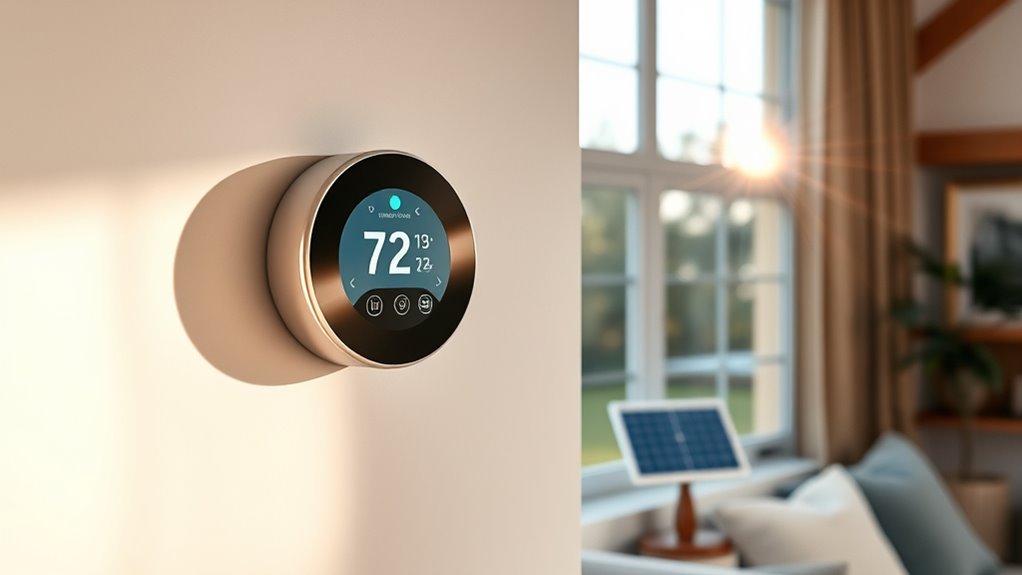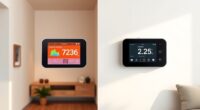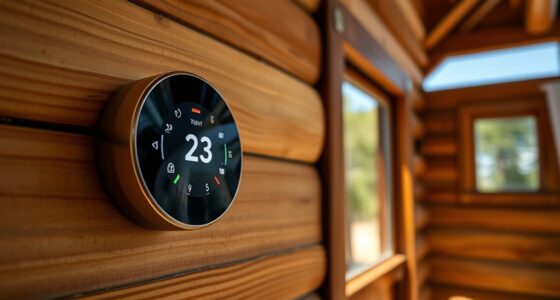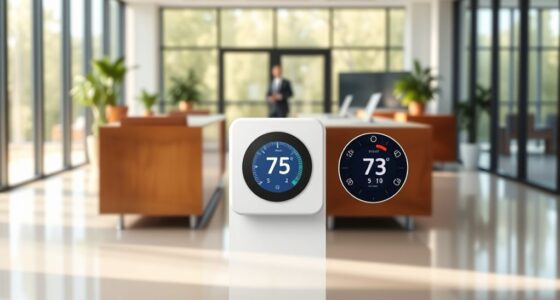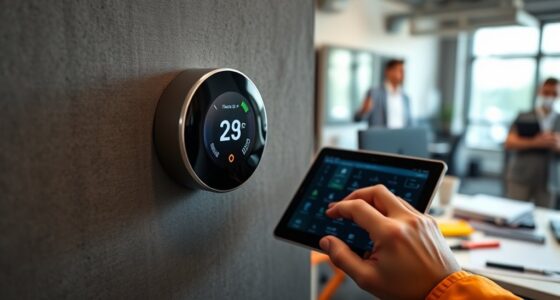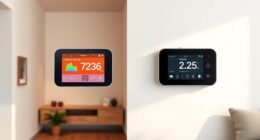When selecting a smart thermostat with solar integration, focus on one that provides energy efficiency benefits like real-time solar monitoring and automatic adjustments based on sunlight. Look for a device with an intuitive interface, compatibility with your existing solar system, and features that support automation and voice control. Reliable brands with responsive support help guarantee long-term performance. Keep exploring to discover how these features can help maximize your solar energy savings and simplify your home comfort management.
Key Takeaways
- Ensure compatibility with your existing solar energy system and smart home devices.
- Look for features like real-time solar output monitoring and solar energy forecasting.
- Prioritize user-friendly interfaces and mobile app control for easy management.
- Choose brands known for reliable hardware, responsive support, and regular firmware updates.
- Verify that the thermostat can automatically adjust heating/cooling based on sunlight availability.
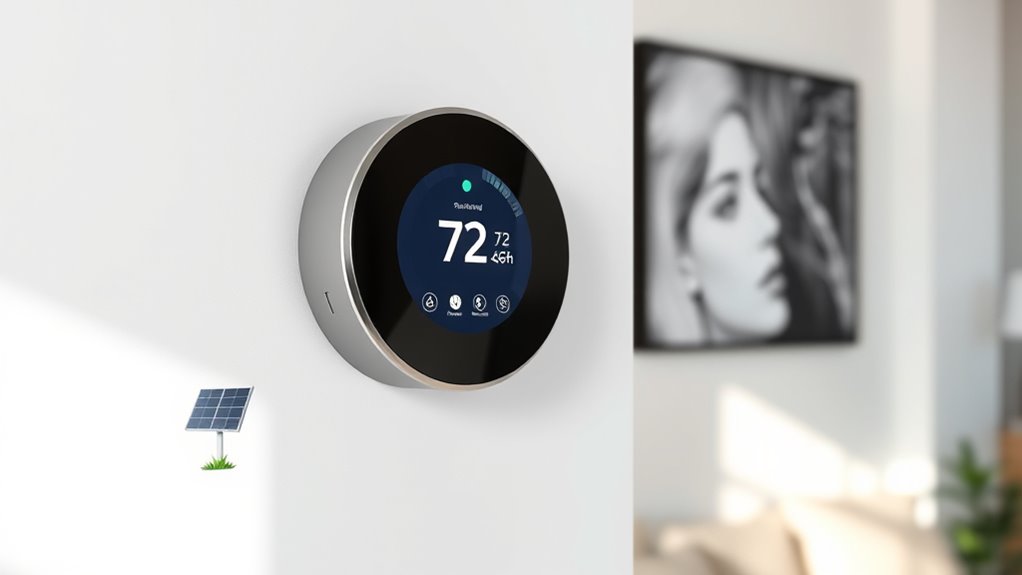
Selecting the right smart thermostat can substantially improve your home’s comfort and energy efficiency. When you’re shopping for a model with solar integration capabilities, it’s essential to focus on how well it balances advanced features with ease of use. One of the most critical aspects to consider is energy efficiency. A smart thermostat that seamlessly integrates with your solar system can optimize when and how your energy is used, helping you cut down on electricity costs and reduce your carbon footprint. Look for models that support real-time data monitoring, so you can see how much energy your solar panels are generating and adjust your thermostat settings accordingly. This ensures you’re maximizing your solar investment while maintaining a comfortable home environment.
Another key factor is the user interface. Since you’ll be interacting with your thermostat regularly, it should be intuitive and straightforward. A cluttered or complicated interface can discourage regular use, undermining the energy-saving potential of your system. Opt for a device that features a clear display, simple navigation, and easy-to-understand controls. Many smart thermostats now offer touchscreen interfaces or mobile apps that allow you to adjust settings from anywhere. When evaluating options, test the responsiveness of the interface and see if it provides helpful insights, such as energy consumption reports or solar energy production data. A well-designed user interface makes managing your home’s climate effortless, ensuring you get the most out of your solar integration without frustration.
Compatibility also plays a vital role. Check whether the thermostat is compatible with your existing solar setup and smart home devices. Some models are designed specifically for solar integration, offering features like solar energy forecasting or automatic adjustments based on sunlight availability. These capabilities can enhance your energy efficiency by aligning heating and cooling schedules with your solar power production, ensuring you’re using your solar energy wisely. Additionally, consider whether the thermostat supports voice control or has automation features that streamline your daily routines. The more seamlessly it integrates into your lifestyle, the more likely you are to consistently use it to optimize your energy consumption.
Lastly, don’t forget about reliability and support. Choose a brand known for durable hardware and responsive customer service. A smart thermostat with solar integration is an investment, and you want a model that will perform well over time. Reading reviews and checking for firmware update options can give you confidence in your choice. With the right combination of energy efficiency features and an easy-to-navigate user interface, you’ll be well on your way to a smarter, greener, and more comfortable home.
Frequently Asked Questions
Can Smart Thermostats With Solar Integration Work With All Types of Solar Panels?
Smart thermostats with solar integration might not function seamlessly with all solar panels. You need to verify panel compatibility and inverter requirements first. Some thermostats are designed for specific inverter types and may require additional hardware to communicate with your solar system. Always confirm that your panels and inverter meet the thermostat’s specifications to guarantee smooth integration and maximum energy management.
What Is the Typical Cost Difference Between Standard and Solar-Compatible Smart Thermostats?
You’ll find that the cost comparison between standard and solar-compatible smart thermostats usually ranges from $50 to $150 more for the solar-compatible versions. The installation cost might be slightly higher too, especially if you need additional wiring or integration work. However, investing in a solar-compatible thermostat can save you money long-term by optimizing your solar energy use and reducing energy bills.
Do Solar-Integrated Thermostats Require Special Wiring or Installation Processes?
Solar-integrated thermostats typically don’t require special wiring or complex installation procedures. However, you should check the wiring requirements, as some models may need additional connections for solar power input or backup batteries. Most installations involve standard wiring methods, but it’s wise to consult the user manual or a professional installer to guarantee proper setup and compatibility with your existing system. This helps ensure maximum performance and safety.
How Do Solar Energy Fluctuations Affect Thermostat Performance?
While solar energy variability might seem like a minor hiccup, it can subtly influence your thermostat’s responsiveness. Fluctuations in solar power may cause slight delays or adjustments in how your smart thermostat operates, especially during cloudy days or peak energy shifts. However, most advanced thermostats are designed to adapt smoothly, maintaining comfort and efficiency by compensating for these solar energy fluctuations, ensuring your system stays reliable.
Are There Any Maintenance Concerns Specific to Solar-Compatible Smart Thermostats?
You should be aware that solar-compatible smart thermostats may require more attention to battery lifespan, as frequent energy fluctuations can drain batteries faster. Additionally, keep up with firmware updates, since they often include bug fixes and improvements for solar integration. Regularly checking and replacing batteries when needed guarantees consistent performance, and staying updated helps your thermostat adapt to solar energy variations effectively.
Conclusion
Now that you’re armed with the knowledge, choosing a smart thermostat with solar integration is like planting a seed for a greener, smarter home. It’s your ticket to harnessing the sun’s power while keeping your comfort in check. Imagine your home as a symphony, where solar energy and smart technology dance in harmony. Make that leap today, and watch your energy savings blossom like a garden in full bloom.
